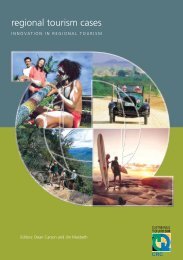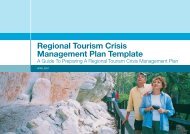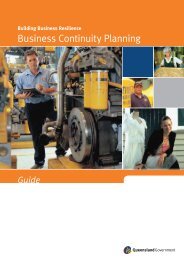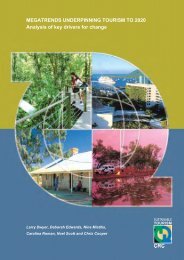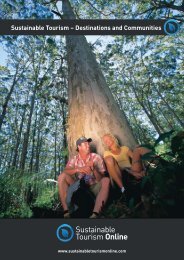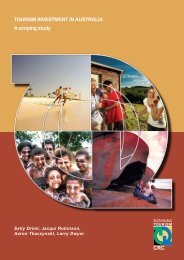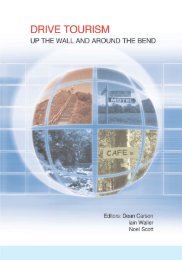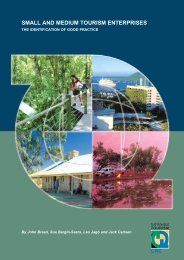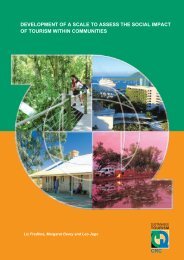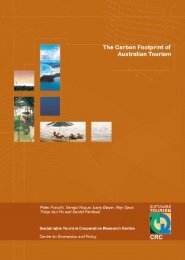The impacts of climate change on australian - Sustainable Tourism ...
The impacts of climate change on australian - Sustainable Tourism ...
The impacts of climate change on australian - Sustainable Tourism ...
Create successful ePaper yourself
Turn your PDF publications into a flip-book with our unique Google optimized e-Paper software.
DEVELOPING ADAPTATION AND RESPONSE STRATEGIES—A SCOPING STUDY<br />
Background<br />
Management <str<strong>on</strong>g>of</str<strong>on</strong>g> Kakadu Nati<strong>on</strong>al Park<br />
Kakadu Nati<strong>on</strong>al Park was declared in three stages from 1981 – 1991 and is jointly managed by a Board <str<strong>on</strong>g>of</str<strong>on</strong>g><br />
Management with representatives from both traditi<strong>on</strong>al and n<strong>on</strong>-traditi<strong>on</strong>al owners. <str<strong>on</strong>g>The</str<strong>on</strong>g> Board currently c<strong>on</strong>sists<br />
<str<strong>on</strong>g>of</str<strong>on</strong>g> 10 representatives <str<strong>on</strong>g>of</str<strong>on</strong>g> traditi<strong>on</strong>al owners and five others, including the Director <str<strong>on</strong>g>of</str<strong>on</strong>g> Nati<strong>on</strong>al Parks,<br />
representatives <str<strong>on</strong>g>of</str<strong>on</strong>g> Parks Australia, a tourism expert and a c<strong>on</strong>servati<strong>on</strong> expert (Director <str<strong>on</strong>g>of</str<strong>on</strong>g> Nati<strong>on</strong>al Parks 2007).<br />
<str<strong>on</strong>g>The</str<strong>on</strong>g> traditi<strong>on</strong>al owners <str<strong>on</strong>g>of</str<strong>on</strong>g> Kakadu are made up <str<strong>on</strong>g>of</str<strong>on</strong>g> many different clan groups and nine major language groups,<br />
collectively referred to as Bininj (Lawrence 2000). Senior clan members have resp<strong>on</strong>sibility for making<br />
decisi<strong>on</strong>s about the management <str<strong>on</strong>g>of</str<strong>on</strong>g> their lands (Director <str<strong>on</strong>g>of</str<strong>on</strong>g> Nati<strong>on</strong>al Parks 2007). Bininj have managed the<br />
country in and around Kakadu since the creati<strong>on</strong> time, when the first ancestors formed the landscape.<br />
Archaeological records show people have occupied the area for at least 50,000 years (Lawrence 2000). Sacred<br />
sites <str<strong>on</strong>g>of</str<strong>on</strong>g> cultural significance and rock art sites occur throughout the park. Approximately half <str<strong>on</strong>g>of</str<strong>on</strong>g> the 19,804 km 2<br />
park is Aboriginal land, which is leased back to the Australian Government for the purpose <str<strong>on</strong>g>of</str<strong>on</strong>g> being managed as<br />
a Comm<strong>on</strong>wealth reserve under the Aboriginal Land Rights (Northern Territory) Act 1976 (Kakadu Board <str<strong>on</strong>g>of</str<strong>on</strong>g><br />
Management 2008).<br />
Kakadu Nati<strong>on</strong>al Park is managed for use by traditi<strong>on</strong>al owners, tourists and recreati<strong>on</strong>al visitors. For<br />
traditi<strong>on</strong>al owners, the wetlands provide an important place for hunting and gathering as well as cerem<strong>on</strong>ies and<br />
cultural activities, such as fire management. Traditi<strong>on</strong>al owners target magpie geese, turtles, mud crabs and fish<br />
such as barramundi and catfish, as well as plants such as water lilies and water chestnut (Bayliss et al. 1997).<br />
Many plants and animals are <str<strong>on</strong>g>of</str<strong>on</strong>g> cultural significance to Bininj, as they have an important totemic role and are<br />
<str<strong>on</strong>g>of</str<strong>on</strong>g>ten used for food or medicine (Director <str<strong>on</strong>g>of</str<strong>on</strong>g> Nati<strong>on</strong>al Parks 2007). In Bininj culture, the history, hydrology,<br />
geology and ecology <str<strong>on</strong>g>of</str<strong>on</strong>g> the natural landscape is central to creati<strong>on</strong> stories and in this way nature and culture are<br />
inextricably linked (Lawrence 2000). Complex traditi<strong>on</strong>al laws govern the use and management <str<strong>on</strong>g>of</str<strong>on</strong>g> wildlife and<br />
habitat according to clan and totem.<br />
Cultural c<strong>on</strong>text<br />
<str<strong>on</strong>g>The</str<strong>on</strong>g> rich Indigenous culture <str<strong>on</strong>g>of</str<strong>on</strong>g> Kakadu Nati<strong>on</strong>al Park is a major draw card for many tourists, who come to learn<br />
from Aboriginal people, visit rock art sites and experience traditi<strong>on</strong>al culture. <str<strong>on</strong>g>The</str<strong>on</strong>g> cultural and spiritual values <str<strong>on</strong>g>of</str<strong>on</strong>g><br />
Kakadu are a str<strong>on</strong>g comp<strong>on</strong>ent <str<strong>on</strong>g>of</str<strong>on</strong>g> marketing the regi<strong>on</strong> within Australia and overseas. <str<strong>on</strong>g>The</str<strong>on</strong>g> interc<strong>on</strong>nectedness<br />
<str<strong>on</strong>g>of</str<strong>on</strong>g> land and culture in Kakadu mean that any envir<strong>on</strong>mental degradati<strong>on</strong> is likely to impact up<strong>on</strong> indigenous<br />
livelihoods, and possibly <strong>on</strong> indigenous tourism, in ways difficult to predict.<br />
Rock art sites within the Park record <str<strong>on</strong>g>change</str<strong>on</strong>g>s in the diet and lifestyle <str<strong>on</strong>g>of</str<strong>on</strong>g> Bininj ancestors over time in<br />
resp<strong>on</strong>se to <str<strong>on</strong>g>change</str<strong>on</strong>g>s in the envir<strong>on</strong>ment. <str<strong>on</strong>g>The</str<strong>on</strong>g> rise in sea level and wetter <str<strong>on</strong>g>climate</str<strong>on</strong>g> at the end <str<strong>on</strong>g>of</str<strong>on</strong>g> the Pre-Estuarine<br />
period 8000 years ago was associated with the appearance <str<strong>on</strong>g>of</str<strong>on</strong>g> the Rainbow Serpent in rock art, a Dreamtime<br />
figure comm<strong>on</strong>ly associated with floods and stories about a sea serpent which eats people. During the Estuarine<br />
period, images <str<strong>on</strong>g>of</str<strong>on</strong>g> fish first appeared, including x-ray style paintings <str<strong>on</strong>g>of</str<strong>on</strong>g> barramundi, mullet, catfish and saltwater<br />
crocodile. <str<strong>on</strong>g>The</str<strong>on</strong>g> Freshwater period 1500 years ago saw the first images <str<strong>on</strong>g>of</str<strong>on</strong>g> freshwater species such as water lilies<br />
and magpie geese appear, mostly painted x-ray style. People were shown collecting magpie goose eggs and<br />
carrying goose feather fans (Chaloupka 1985 in Brockwell, Levitus, Russell-Smith & Forrest 1995). This<br />
coincides with geological evidence suggesting the freshwater wetlands formed at this time (Lawrence 2000).<br />
<str<strong>on</strong>g>The</str<strong>on</strong>g> rock art <str<strong>on</strong>g>of</str<strong>on</strong>g> Kakadu provides evidence showing that Aboriginal people <str<strong>on</strong>g>of</str<strong>on</strong>g> the area have adapted to a large<br />
degree <str<strong>on</strong>g>of</str<strong>on</strong>g> envir<strong>on</strong>mental <str<strong>on</strong>g>change</str<strong>on</strong>g> over the past 8000 years associated with changing climatic c<strong>on</strong>diti<strong>on</strong>s. Bininj<br />
have lived in the regi<strong>on</strong> for over 50,000 years and have witnessed a great deal <str<strong>on</strong>g>of</str<strong>on</strong>g> envir<strong>on</strong>mental <str<strong>on</strong>g>change</str<strong>on</strong>g> during<br />
this time, including the recent col<strong>on</strong>isati<strong>on</strong> <str<strong>on</strong>g>of</str<strong>on</strong>g> Europeans (Lawrence 2000). Although it is now occurring at a<br />
faster rate, the traditi<strong>on</strong>al owners <str<strong>on</strong>g>of</str<strong>on</strong>g> Kakadu Nati<strong>on</strong>al Park see <str<strong>on</strong>g>climate</str<strong>on</strong>g> <str<strong>on</strong>g>change</str<strong>on</strong>g> as something that is not new to<br />
them. <str<strong>on</strong>g>The</str<strong>on</strong>g> <str<strong>on</strong>g>change</str<strong>on</strong>g>s in lifestyle as they adapted to different <str<strong>on</strong>g>climate</str<strong>on</strong>g>s are recorded not <strong>on</strong>ly in rock art, but also in<br />
stories handed down through the generati<strong>on</strong>s (Yibarbuk 2008).<br />
For our people, there is nothing new in <str<strong>on</strong>g>climate</str<strong>on</strong>g> <str<strong>on</strong>g>change</str<strong>on</strong>g>—we have known all al<strong>on</strong>g, through the stories from the<br />
old people… <str<strong>on</strong>g>The</str<strong>on</strong>g> <str<strong>on</strong>g>change</str<strong>on</strong>g>s we are looking at today are not natural <str<strong>on</strong>g>change</str<strong>on</strong>g>—they are caused by people, not nature.<br />
(Yibarbuk 2008)<br />
Sacred sites occur throughout Kakadu Nati<strong>on</strong>al Park and include areas <str<strong>on</strong>g>of</str<strong>on</strong>g> the landscape associated with<br />
important Creati<strong>on</strong> ancestors, <str<strong>on</strong>g>of</str<strong>on</strong>g>ten referred to as djang. Disturbing or visiting these areas inappropriately is<br />
perceived by traditi<strong>on</strong>al owners to be very dangerous and is <str<strong>on</strong>g>of</str<strong>on</strong>g>ten associated with sickness and envir<strong>on</strong>mental<br />
disasters (Brockwell et al. 1995). For this reas<strong>on</strong>, management <str<strong>on</strong>g>of</str<strong>on</strong>g> sacred sites is very important for Bininj and for<br />
tourism planning.<br />
21



